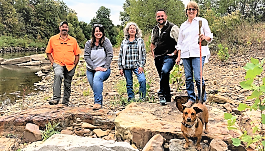New funding furthers Northwest Arkansas source water protection efforts
December 7, 2022

AWWA Articles
New funding furthers Northwest Arkansas source water protection efforts
Beaver Watershed Alliance (BWA), in partnership with Beaver Water District (BWD) and the Watershed Conservation Resource Center (WCRC), is receiving $5 million in funding for a Northwest Arkansas source water protection program.
 Funding for the program, called the War Eagle Creek Watershed Initiative, will be provided through the Regional Conservation Partnership Program (RCPP) within the Natural Resource Conservation Service (NRCS). Funding includes $2.4 million from the NRCS and an additional $2.6 million cash and in-kind match from partners. The primary match partner, BWD, will contribute $745,000 in cash and $1.3 million in-kind to the project over five years.
Funding for the program, called the War Eagle Creek Watershed Initiative, will be provided through the Regional Conservation Partnership Program (RCPP) within the Natural Resource Conservation Service (NRCS). Funding includes $2.4 million from the NRCS and an additional $2.6 million cash and in-kind match from partners. The primary match partner, BWD, will contribute $745,000 in cash and $1.3 million in-kind to the project over five years.
“Beaver Water District is able to provide a cash match through our source water protection fund; we set aside $0.04 per every thousand gallons of drinking water we sell to go toward these types of programs,” said Dr. James McCarty, BWD’s environmental quality manager. (Pictured above, representatives from partners in the War Eagle Creek Watershed Initiative stand on a restored section of West Fork White River. Photo credit KUAF Radio.)
The War Eagle Creek Watershed is the largest of the six tributaries of the White River that forms Beaver Lake. It is 52% forest, 37% pasture, and contains 1,300 miles of unpaved roads. The War Eagle Creek Watershed Initiative will protect drinking water for more than 550,000 Arkansans, improve the local farming economy, wildlife, and aquatic ecosystems, and address environmental concerns impacting soil, water, plants and animals.
The latest funding will build on the success that BWD and other conservation partners achieved through the recently completed West Fork White River RCPP program, which included large-scale stream restoration work, landowner best management practices, and education and outreach.
 “Our success on the West Fork definitely encouraged us to apply again and I believe it increased our competitiveness in the application process,” said McCarty.
“Our success on the West Fork definitely encouraged us to apply again and I believe it increased our competitiveness in the application process,” said McCarty.
“Funding for the War Eagle Creek Watershed Initiative will go toward a variety of projects focused on three important areas: sediment catchment, river and riparian restoration, and unpaved roads,” he added. “Each of these are important for reducing sediment and nutrient runoff to our drinking water source.”
The West Fork of the White River was recently highlighted as a success story by the U.S. Environmental Protection Agency after a large segment of the river was removed from the state’s list of water bodies with water quality impairments.
The new initiative will include sediment catchment done via a new take on an old conservation practice. Specially designed ponds will be installed in headwater areas to capture runoff and slowly drain the water, capturing sediment in the process and slowing down water velocity in headwater streams.
In addition, river and riparian restoration work will help stabilize streambanks responsible for the majority of sediment that drains to Beaver Lake.
Unpaved roads are also a major source of sediment during runoff events. The initiative will work with the Arkansas Unpaved Roads Program to implement tried and tested practices that help maintain unpaved roads in peak condition and mitigate sediment loss.
Other partners in the War Eagle Creek Watershed Initiative include:
- Northwest Arkansas Land Trust
- Arkansas Game and Fish Commission
- H2Ozarks
- Farm Bureau
- Arkansas Department of Agriculture
- Madison and Washington Counties Soil and Water Districts
- Arkansas Archaeological Survey
- Hispanic Women’s Organization of Arkansas
Advertisement